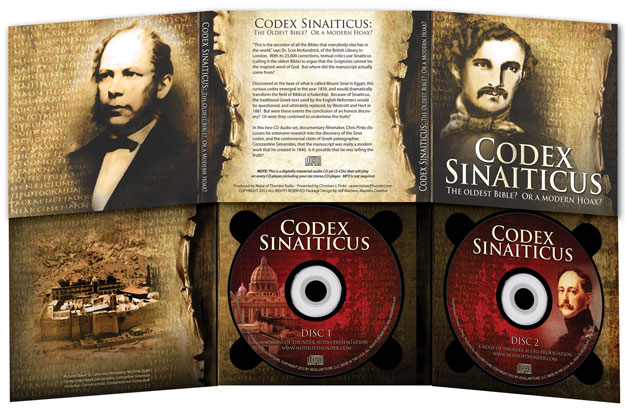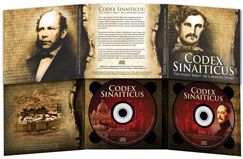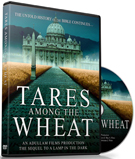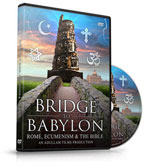| AUDIO PREVIEW - Preview this audio CD by listening to this audio clip. |
DESCRIPTION
"This is the ancestor of all the Bibles that everbody else has in the world," says Dr. Scot McKendrick, of the British Library in London. With its 23,000 corrections, textual critics use Sinaiticus (calling it the oldest Bible) to argue that the Scriptures cannot be the inspired word of God. But where did the manuscript actually come from?
Discovered at the base of what is called Mount Sinai in Egypt, this curious codex emerged in the year 1859, and would dramatically transform the field of Biblical scholarship. Because of Sinaiticus, the traditional Greek text used by the English Reformers would be questioned, and ultimately replaced, by Wescott and Hort in 1881. But were these events the conclusion of an honest discovery? Or were they contrived to undermine the truth?
In this two-CD Audio set, documentary filmmaker, Chris Pinto discusses his extensinve research into the discovery of the Sinai codex, and the controversial claim of Greek paleographer, Costandine Simonides, that the manuscript was really a modern work that he created in 1840. Is it possible that he was telling the truth?
Included in this Audio Presentation:
1) How Codex Sinaiticus changed the world's view of the Bible
2) How the manuscript was used to "confirm" the Vatican's Bible -- Codex Vaticanus
3) The Westcott and Hort plan to create a new Greek Bible
4) The story of Simonides in his own words
5) How Tischendorf accused Simonides of forgery and later recanted
6) Tischendorf's relationship with Rome
7) How the details given by Simonides are confirmed by the manuscript evidence
8) The mention of worm holes and why they may be significant
9) The names of Simonides' helpers found in the manuscript
10) Special markings discovered in 2007 that may be from Simonides
11) Was Simonides really a forger, or was he falsely accused?
Note: This is a digitally mastered audit CD set (2-CDs) that will play on every CD player, including your car stereo CD player. MP3 is not required.
Produced by Noise of Thunder Radio, An Adullam Films Ministry - Presented by Christian J. Pinto - www.noiseofthunder.com
______________________________________________________________________________
UPDATE: The new "Codex Sinaiticus" audio CD, our follow up release to “Tares Among the Wheat” has proven to be quite controversial in the past few months. It has sparked debates across the Internet, as the critical text defenders have begun to challenge the story of Constantine Simonides, who claimed to have created the Codex Sinaiticus in 1840. Against them are the defenders of the traditional Greek text of the Protestant Reformation, who are challenging the credibility of the Codex Sinaiticus, and whether or not it should have been entered into the Biblical record. Why? Because the manuscript is of highly suspicious character – with 23,000 corrections, averaging 30 corrections per page. Since its discovery in 1859, it has been surrounded by suspicion and debate.
A SETTLED DISPUTE?
While most modern scholars have been led to believe that the controversy over Simonides’ story was settled in the nineteenth century, it is important to consider that there were those who disagreed. One such person was John Eliot Hodgkin, curator of the Mayer Museum in Liverpool, whose writing collection is still housed at the British Library. Hodgkin was a zealous defender of Simonides, who stood by him until death. Also among them, was renowned scholar, James A. Farrer who published his classic work, Literary Forgeries in 1907. Of all the historians who have written on this matter, we believe Farrer to be the most thorough. After examining the details of the Simonides affair, he wrote:
“It is to be regretted that this matter was never cleared up at the time the claim was made. It cannot be said to have been settled by the mere opinions of Tregelles or Bradshaw, or by the more critical and palaeographical objections urged by Mr. Scrivener…. On the side of Simonides is his unlimited skill in calligraphy; the very audacity of such a claim if entirely baseless; the remarkable presence in the Codex of a portion of the Shepherd of Hermas, which Simonides was the first scholar ever to have seen in Greek; the very natural allusions to the work in the lithographed letters (sent by a friend of Simonides years before the controversy); the fact that no visitor to the monastery at Mount Sinai before 1844 had ever seen or heard of such a work as belonging to the monks; and the very extraordinary story told by Tischendorf of his discovery and acquisition of the Codex. The question therefore, pending the acquisition of further evidence, must remain among the interesting but unsolved mysteries of literature.” (Literary Forgeries, by James A. Farrer, 1907, pp. 64-65, emphasis added)
Notice that Farrer refers to the issue as one of the “unsolved mysteries of literature” nearly fifty years after these events happened. This is something they don’t teach at Bible colleges, but that is the whole purpose of the work we do. Our desire is to alert the Church to important issues, not for the purpose of stirring up controversy, but for edification, so that the faith of the Gospel might be better defended. It is important to remember that the Codex Sinaiticus is used by higher critics to undermine and discredit the Bible. Not just the King James Bible, but any Bible. As such, we believe that having a true and accurate history of the codex is very important for the Church.
To learn more about the men mentioned above (Tregelles, Bradshaw, Scrivener), we recommend viewing the film, "Tares Among the Wheat" where the role of these historic figures is explained.
Also, to understand what we mean about how Sinaiticus is used to discredit the Bible, we recommend viewing this seven minute clip from the BBC documentary, The Beauty of Books: Ancient Bibles, the Codex Sinaiticus.
http://www.youtube.com/watch?v=kCkyakphoKE





